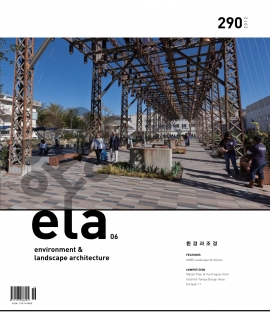Q. 현재 조경분야에 대한 당신의 견해는 무엇인가요? 랜드스케이프 어바니 즘을 둘러싸고 최근 업계 내에서 벌어지고 있는 논의가 당신에게 어떤 영향을 미치고 있습니까?
A. 수년 전부터 하버드대학의 찰스 왈드하임(Charles Waldheim)을 비롯한 전 세계의 많은 사람들이 랜드스케이프 어바니즘에 대해 활발한 토론을 벌이고 있습니다. 도시의 모습을 만들어나갈 수 있는 일종의 방법론이자 개념 적 구조로서 말입니다. 비록 랜드스케이프 어바니즘이 보통사람들에게는 여전히 낯선 개념일지 모르지만, 이러한 움직임을 통해 조경이 일반 대중에 대해 갖는 의미는 더욱 커질 것입니다. 저는 랜드스케이프 어바니즘이 지속가능성과 도시 기반시설로서의 조경의 역할에 대해 중요한 질문들을 제기하고 있다고 생각합니다. 매일매일 도시에서 살아가고 있는 우리들은 자연 및 생태환경과 어떤 관계를 맺고 있을까요? 도시 기반시설이 자연의 시스템을 닮아가려면 어떻게 해야 할까요? 도시를 풍요롭게 하는 기반시설로서 자연을 새롭게 받아들이기 위해 어떤 노력이 필요할까요? 저탄소 경제를 기반으로 하는 지속가능한 도시의 모습은 과연 어떠할까요? 우리가 정말 지속가능한 방향으로 가고 있는지, 그리고 그 수준이 어느 정도인지 어떻게 알 수 있을까요? 흥미로운 이야깃거리로서의 지속가능성이 아닌 삶의 방식, 나아가 존재의 방식으로서의 지속가능성을 확보하려면 어떤 방법을 써야할까요? 이러한 근본적 질문들이 AHBE가 시행하고 있는 작업의 근간을 이루고 있습니다.
저는 AHBE의 사무실 공간을 비롯한 로스앤젤레스 도심 전역이 랜드스케이프 어바니즘을 검증해볼 수 있는 살아있는, 진정한 실험의 장이라 생각합니다. 2년 전 우리 회사에서는 랜드스케이프 어바니즘과 관련하여 AHBE의 면모를 일신할 수 있는 연구를 진행하였습니다. 예를 들어 우리는 버뱅크시(Burbank)와 함께 기존의 낡은 수자원/에너지 관련 시설을 캘리포니아에서 가장 지속가능성이 높은 산업시설로 탈바꿈시켰습니다.
이 프로젝트는 조경디자인에 있어서 구체적 지침과 기준을 마련하고자 미국조경가협회(American Society of Landscape Architects)가 추진한 “SITES” 파일럿 프로젝트의 일환으로 진행되었습니다. 또한 우리는 지난 3년간 로스앤젤레스 도심에 위치한 호프 스트리트(Hope Street) 프로젝트에 대한 관찰 및 평가를 계속해왔는데, 이를 통해 지속가능한 거리 디자인이 건조한 지중해성 기후 아래에서 어떤 효용을 나타낼 수 있는지 알게 되었습니다. 끝으로 우리는 최근 로스앤젤레스시에 위치한 버몬트 미디언 파크(Vermont Median Park)의 마스터플랜을 마련하였습니다. 이 계획을 통해 주로 차량 통행 용도로 사용되던 도로가 다양한 기능을 수행하는 복합 대로로 변모하게 될 것입니다. 직선형으로 설계된 공원을 통해 활발한 여가 생활을 북돋우는 한편 자연서식지를 제공하게 됩니다. 또한 320에이커에 달하는 주변 지역을 위한 빗물처리 및 정수시설을 확보하게 됩니다.
Q. What is your view of landscape architecture today and how is your practice today informed by the discussions taking place within the profession regarding Landscape Urbanism?
For the last several years, Charles Waldheim of Harvard University and others around the world have been at the forefront of the discussion about Landscape Urbanism as a methodology and conceptual structure to shape urban form. Although
the theory of Landscape Urbanism is not yet part of the public conversation, the role of landscape will become more relevant to the general public as a result of the movement.
From my perspective, Landscape Urbanism raises important questions about sustainability and the role of landscape as urban infrastructure: What is our relationship to nature and ecology, on an everyday basis, within the city? How can the city’s infrastructure be informed by natural systems? Or, how can we reintroduce nature as a formal infrastructure that services our city? What will a sustainable city look like based on a non-carbon economy? How do we know if we are making a difference from a sustainability standpoint and how do we measure the daily differences in the city? How do we shift the cultural conversation from sustainability as a popular idea to sustainability as a way of life or being? These fundamental questions are the basis of AHBE’s practice.
I consider AHBE’s office space and the broader area of metropolitan Los Angeles as living and real laboratories of Landscape Urbanism. A couple of years ago, we established an initiative at the firm to use research as a way of reformulating AHBE relative to Landscape Urbanism. For example, we have been working with the City of Burbank in its transformation of an existing water and power facility into one of the most sustainable industrial sites in California. The project is also one of the pilot projects for the American Society of Landscape Architects’ “Sustainable Site Initiatives,” which is creating a national guideline and performance benchmark for landscape design through a methodology of research, data collection, and testing. For the last three years, we have also been monitoring and testing our Hope Street project in Downtown Los Angeles to determine the actual efficacy of how a sustainable street design (also known as “green streets” in our vernacular) works in an arid Mediterranean climate. Lastly, we recently completed a master plan for the Vermont Median Park in the City of Los Angeles which re-purposes an existing boulevard to serve multiple functions beyond its original function as a transportation corridor. Our design proposed a linear public park that provides active recreation while also serving as a habitat corridor for the “Pacific Fly Zone” and a major stormwater infiltration and filtration system for over 320 acres of surrounding neighborhoods.





